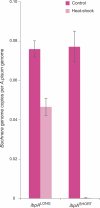Aphid thermal tolerance is governed by a point mutation in bacterial symbionts
- PMID: 17425405
- PMCID: PMC1847839
- DOI: 10.1371/journal.pbio.0050096
Aphid thermal tolerance is governed by a point mutation in bacterial symbionts
Abstract
Symbiosis is a ubiquitous phenomenon generating biological complexity, affecting adaptation, and expanding ecological capabilities. However, symbionts, which can be subject to genetic limitations such as clonality and genomic degradation, also impose constraints on hosts. A model of obligate symbiosis is that between aphids and the bacterium Buchnera aphidicola, which supplies essential nutrients. We report a mutation in Buchnera of the aphid Acyrthosiphon pisum that recurs in laboratory lines and occurs in field populations. This single nucleotide deletion affects a homopolymeric run within the heat-shock transcriptional promoter for ibpA, encoding a small heat-shock protein. This Buchnera mutation virtually eliminates the transcriptional response of ibpA to heat stress and lowers its expression even at cool or moderate temperatures. Furthermore, this symbiont mutation dramatically affects host fitness in a manner dependent on thermal environment. Following a short heat exposure as juveniles, aphids bearing short-allele symbionts produced few or no progeny and contained almost no Buchnera, in contrast to aphids bearing symbionts without the deletion. Conversely, under constant cool conditions, aphids containing symbionts with the short allele reproduced earlier and maintained higher reproductive rates. The short allele has appreciable frequencies in field populations (up to 20%), further supporting the view that lowering of ibpA expression improves host fitness under some conditions. This recurring Buchnera mutation governs thermal tolerance of aphid hosts. Other cases in which symbiont microevolution has a major effect on host ecological tolerance are likely to be widespread because of the high mutation rates of symbiotic bacteria and their crucial roles in host metabolism and development.
Conflict of interest statement
Figures






Comment in
-
When bacteria lose a single DNA base, aphids suffer.PLoS Biol. 2007 May;5(5):e126. doi: 10.1371/journal.pbio.0050126. Epub 2007 Apr 10. PLoS Biol. 2007. PMID: 20076671 Free PMC article. No abstract available.
References
-
- Shigenobu S, Watanabe H, Hattori M, Sakaki Y, Ishikawa H. Genome sequence of the endocellular bacterial symbiont of aphids Buchnera sp. APS. Nature. 2000;407:81–86. - PubMed
-
- Baumann P. Biology of bacteriocyte-associated endosymbionts of plant sap-sucking insects. Annu Rev Microbiol. 2005;59:155–189. - PubMed
-
- Tamas I, Klasson L, Canback B, Naslund AK, Eriksson AS, et al. 50 Million years of genomic stasis in endosymbiotic bacteria. Science. 2002;296:2376–2379. - PubMed
-
- Moran NA, Munson MA, Baumann P, Ishikawa H. A molecular clock in endosymbiotic bacteria is calibrated using the insect hosts. Proc Roy Soc Lond B Biol Sci. 1993;253:167–171.
-
- Ohtaka C, Ishikawa H. Effects of heat treatment on the symbiotic system of an aphid mycetocyte. Symbiosis. 1991;11:19–30.
Publication types
MeSH terms
Substances
Associated data
- Actions
- Actions
- Actions
- Actions
- Actions
- Actions
Grants and funding
LinkOut - more resources
Full Text Sources
Molecular Biology Databases

